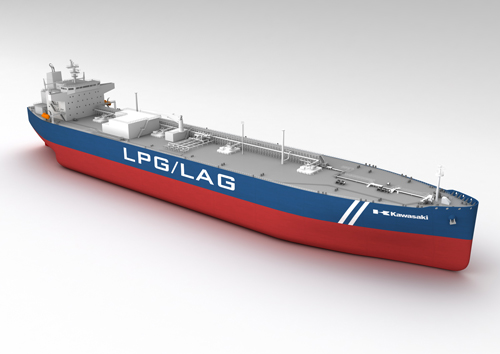Kawasaki Receives an Order for an 86,700 m³ LPG-fueled LPG/ LAG Carrier
Oct. 04, 2021

Tokyo, October 4, 2021 — Kawasaki Heavy Industries, Ltd. announced today that it has concluded a shipbuilding contract for an 86,700 m3 liquefied petroleum gas (LPG) and liquefied ammonia gas (LAG) carrier powered by LPG fuel for ENEOS Ocean Corporation. This is the 2nd LPG/LAG carrier for ENEOS Ocean Corporation.
The vessel is equipped with separate cargo tanks designed to carry LPG and LAG at the same time. This contract represents their 73rd LPG carrier, 10th LPG-fueled LPG carrier and 3rd LPG/LAG carrier to be constructed by Kawasaki. Kawasaki plans to complete the construction of the vessel at its Sakaide Works in 2023.
The advantage of this dual-purpose vessel is its capability to simultaneously carry LPG, which is already used as a low-carbon energy source, and LAG, a new fuel contributing to the establishment of a decarbonized society. Another feature is the greater capacity of the cargo tanks as compared to conventional carriers, which was achieved without significantly changing the vessel’s length, breadth, or other main specifications.
Fueled by low-sulfur fuel oil and LPG (which significantly reduces the emission volumes of sulfur oxides [SOx], CO2, and other pollutants in the exhaust gases as compared to marine fuel oil), the vessel meets SOx emission standards set by the International Maritime Organization (IMO)*1, as well as the IMO’s Energy Efficiency Design Index (EEDI)*2 Phase 3 regulations, which are scheduled to adopt stricter CO2 emission standards in 2022.
To meet environmental standards being tightened globally, and to implement action plans set forth in the Sustainable Development Goals (SDGs) adopted by the United Nations and other initiatives, Kawasaki plans to develop and build more LPG-fueled LPG carriers and other commercial vessels that meet environmental standards, as well as to develop other eco-friendly marine technologies, to contribute to the establishment of a low-carbon/decarbonized society. These products include vessels for transporting liquefied hydrogen, considered to be the next-generation energy source.
| Specifications | |
|---|---|
| Length overall | Approx. 230.00 m |
| Breadth | 37.20 m |
| Depth | 21.90 m |
| Summer draft | 11.65 m |
| Tank capacity | 86,700 m3 |
| *1 | SOx emission standards: Since January 2015, SOx emission regulations specifying a fuel sulfur content of 0.1% or less have been enacted in the Emission Control Areas (ECAs) of Europe and America. In addition, beginning in January 2020, vessels traveling in marine areas in all other parts of the world are required to use fuels with a sulfur content of 0.5% or less, or to use alternative equipment to reduce the SOx content of exhaust gases to an equivalent level. |
| *2 | Energy Efficiency Design Index (EEDI) regulation: An international regulation that enforces compliance of newly-constructed vessels with energy-saving performance regulation values using the Energy Efficiency Design Index (EEDI), which is defined as the number of grams of CO2 emitted when transporting one ton of cargo over one mile. Required EEDI regulation values are made stricter in phases according to the construction contract and delivery dates. For some types of vessels such as large LPG carriers and LNG (liquefied natural gas) carriers, compliance with Phase 3 (30% reduction in CO2 emissions from the baseline [Phase 0]) is required for vessels contracted for construction in 2022 and later. |
Contact
If you need more information about our business,
please feel free to contact us.





